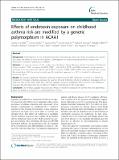| dc.contributor.author | Sordillo, Joanne | |
| dc.contributor.author | Sharma, Sunita | |
| dc.contributor.author | Poon, Audrey | |
| dc.contributor.author | Su, Jessica Ann Lasky | |
| dc.contributor.author | Belanger, Kathleen | |
| dc.contributor.author | Milton, Donald Kirby | |
| dc.contributor.author | Bracken, Michael B | |
| dc.contributor.author | Triche, Elizabeth W | |
| dc.contributor.author | Leaderer, Brian P | |
| dc.contributor.author | Gold, Diane R. | |
| dc.contributor.author | Litonjua, Augusto Ampil | |
| dc.date.accessioned | 2012-04-19T19:00:58Z | |
| dc.date.issued | 2011 | |
| dc.identifier.citation | Sordillo, Joanne E, Sunita Sharma, Audrey Poon, Jessica Lasky-Su, Kathleen Belanger, Donald K Milton, Michael B Bracken, Elizabeth W Triche, Brian P Leaderer, Diane R Gold, and Augusto A Litonjua. 2011. Effects of endotoxin exposure on childhood asthma risk are modified by a genetic polymorphism in acaa1. BMC Medical Genetics 12: 158 | en_US |
| dc.identifier.issn | 1471-2350 | en_US |
| dc.identifier.uri | http://nrs.harvard.edu/urn-3:HUL.InstRepos:8603141 | |
| dc.description.abstract | Background: Polymorphisms in the endotoxin-mediated TLR4 pathway genes have been associated with asthma and atopy. We aimed to examine how genetic polymorphisms in innate immunity pathways interact with endotoxin to influence asthma risk in children. Methods: In a previous analysis of 372 children from the Boston Home Allergens and the Connecticut Childhood Asthma studies, 7 SNPs in 6 genes (CARD15, TGFB1, LY96, ACAA1, DEFB1 and IFNG) involved in innate immune pathways were associated with asthma, and 5 SNPs in 3 genes (CD80, STAT4, IRAK2) were associated with eczema. We tested these SNPs for interaction with early life endotoxin exposure (n = 291), in models for asthma and eczema by age 6. Results: We found a significant interaction between endotoxin and a SNP (rs156265) in ACAA1 (p = 0.0013 for interaction). Increased endotoxin exposure (by quartile) showed protective effects for asthma in individuals with at least one copy of the minor allele (OR = 0.39 per quartile increase in endotoxin, 95% CI 0.15 to 1.01). Endotoxin exposure did not reduce the risk of asthma in children homozygous for the major allele. Conclusion: Our findings suggest that protective effects of endotoxin exposure on asthma may vary depending upon the presence or absence of a polymorphism in ACAA1. | en_US |
| dc.language.iso | en_US | en_US |
| dc.publisher | BioMed Central | en_US |
| dc.relation.isversionof | doi:10.1186/1471-2350-12-158 | en_US |
| dc.relation.hasversion | http://www.ncbi.nlm.nih.gov/pmc/articles/PMC3252252/pdf/ | en_US |
| dash.license | LAA | |
| dc.title | Effects of Endotoxin Exposure on Childhood Asthma Risk are Modified by a Genetic Polymorphism in ACAA1 | en_US |
| dc.type | Journal Article | en_US |
| dc.description.version | Version of Record | en_US |
| dc.relation.journal | BMC Medical Genetics | en_US |
| dash.depositing.author | Sordillo, Joanne | |
| dc.date.available | 2012-04-19T19:00:58Z | |
| dc.identifier.doi | 10.1186/1471-2350-12-158 | * |
| dash.contributor.affiliated | Milton, Donald | |
| dash.contributor.affiliated | Sordillo, Joanne | |
| dash.contributor.affiliated | Sharma, Sunita | |
| dash.contributor.affiliated | Gold, Diane | |
| dash.contributor.affiliated | Litonjua, Augusto A. | |
| dash.contributor.affiliated | Lasky-Su, Jessica | |


